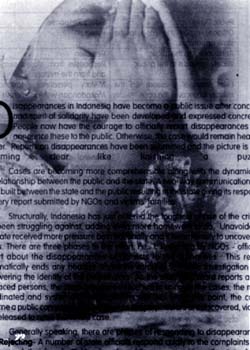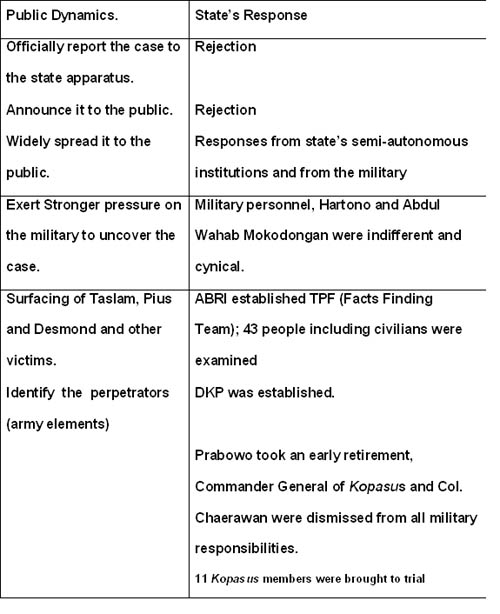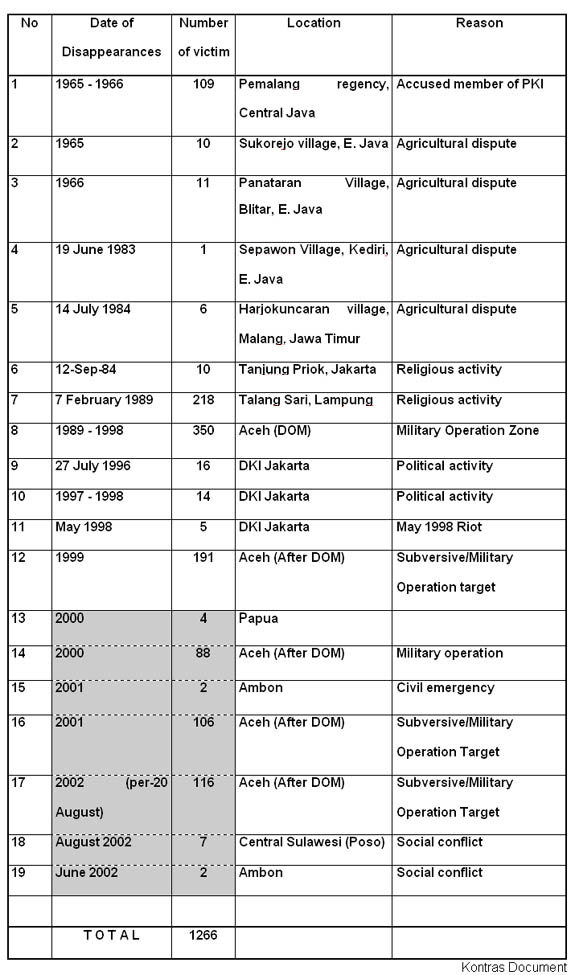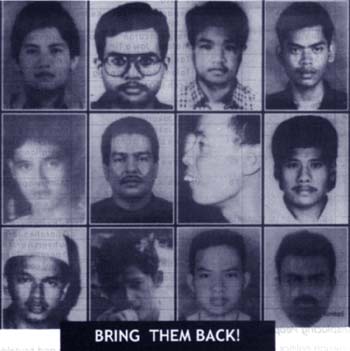Four Years Effort
to Revealing Disappearances: A Reflection
 Disappearances in Indonesia have become a public issue after concerns and spirit of solidarity has been developed and expressed concretely. People now have the courage to officially report disappearances and announce them to the public. Otherwise, the case would remain hearsay forever. Reports on disappearances have been submitted and the picture is now becoming clear like finishing a puzzle.
Disappearances in Indonesia have become a public issue after concerns and spirit of solidarity has been developed and expressed concretely. People now have the courage to officially report disappearances and announce them to the public. Otherwise, the case would remain hearsay forever. Reports on disappearances have been submitted and the picture is now becoming clear like finishing a puzzle.
Cases are becoming more comprehensible along with the dynamics of the relationship between the public and the state. A two-way communication has been built between the state and the public resulting in the state giving its response to every report submitted by NGOs and victims’ families.
Structurally, Indonesia has just entered the toughest phase of the crisis it has been struggling with, adding even more homework to do. Unavoidably, the state received more pressure both nationally and internationally to uncover the cases. There are three phases in the effort, i.e.: 1. Reporting NGOs- officially report the missing of activists to the authorities. This report automatically ends any hearsay about the missing; 2. Public Investigation and discovering the perpetrators- As the state gets more reports about displaced persons, the more pressure it receives to uncover the cases and consequently the more coordinated and systematic investigations will be. From this point, the cases become public concern; 3. Recovering- as the perpetrators are discovered, victims are released to retell the whole case.
Generally speaking, there are phases of responding to disappearances, i.e.
1) Rejecting- A number of state officials respond coldly to the case and tend to wash their hands; 2).
Hearing- As public pressure widens, the state should open forums for a hearing yet, state officials remain cautious; 3).
Data Gathering- Government established a Fact Finding Team, particularly after Pius, Desmon and Taslam were released; 4)
Political Solution- Once the data has been gathered ,The Kopasus’ involvement was becoming clearer . Government then established the DKP that brought Prabowo, Muchdi and Chaerawan on trial; and 5).
Legal Solution- Prabowo took early retirement, Muchdi and Chaerawan were dismissed from the armed forces, 10 members of
Kopasus’ were brought to the military court.
The table below shows the dynamics of the process:
1. Chart on State-Public Relation: Abduction Cases
Courtesy: Kompas

n abduction/disappearance cases in Jakarta, almost all victims are individuals who are active in activities resisting the present political reign. They were: Andi Arief, Feisol Reza, Herman Hendrawan
(Partai Rakyat Demokratik activists); Desmond Mahesa (LBHN activist); Haryanto Taslam (one of PDI-P top persons). Based the evidence, violence and disappearances of people in Indonesia have reached a treacherous 2-pronged level: The first prong is where the military “by instinct” and for no other reason can commit violence and displace any one as happened in Aceh. On the second prong, disappearances of people are part of a premeditated, systematical project to sustain power and thwart the opposition.
Starting with uncovering the case in Jakarta, hopefully other cases in the regions will also be discovered.
2. Tabulation of Involuntary Disappearances Victims in Indonesia: 1965 – 2002

The Politics of Displacing People
Indonesian politics during the New Order regime allowed violence and brutality against humanity”. It seems that disappearances of people and violence became an official political method up until the present. In this context, social-political institutions that should protect and safeguard the people officially become the perpetrator of crimes against humanity.
The following facts strengthen the above proposition:
First, most of those kidnapped were young activists, who are mostly against the status quo group.
Second, the most politically damaging abduction occurred during the period when the ruling group was about to a general assembly.
Third, structurally, those in power were facing a multi-dimensional deterioration due to the economic crisis.
Fourth, in such a situation, the peoples’ movement against the ruling government was getting stronger and stronger. The movement itself was massive, continuous and student-based.
Fifth, in such a situation, unavoidably there was clear conflict both within the state circle and between the social elements and the state.
We can simply conclude that the abduction took place during the government’s most sensitive movement toward change. As announced, this fact was affirmed that along with Suharto’s fall, the one to blame for the abduction was Lt. Gen. Prabowo Subianto.
Follow-up Efforts in Uncovering Disappearances

Various efforts have been made by victims families under the umbrella of IKOHI (Association of the Families of Displaced People) and The
KontraS to hold the state responsible for the cases. The efforts took the form of campaign, nationally and internationally. Official findings by institutions were expected to help law enforcement on the cases.
So far, the efforts exerted have not been very fruitful. The State’s reticence and political attitude on disappearances was one of the main factors impeding the legal mechanism in the case. The implications from this case also effects other cases of crime against humanity. Because of the slow progress in legal processes on the continuance of violence, victims, victims’ families and
KontraS all know the violation of human rights can only be ended through a change in the state-civil society relationship. In encouraging these processes, civil society’s support is highly regarded. The fact is that disappearances hardly get the state’s attention and response, and is related to another fact that the old and new authoritarian powers reconsolidate. Those powers muster strength using the historical legitimacy (NKRI) and particular international support (Anti Terrorism Campaign) to instill public discipline. There is no other way to break through the dead end and the public weakness than by destroying the stones of sectarianism in politics and social life and develop political communication to achieve consolidation where differences become assets in order to beat authoritarianism.
Conclusion
Based on the above notes, KONTRAS draws the following conclusions:
First, Involuntary Disappearance is a crime against humanity. Responsibility lies on the perpetrators and all related individuals and institutions, especially those who have direct involvement in the cases.
Second, Unavoidably, military’s officials should be seen as part of the hierarchy of power. Hence, all of them subordinating Prabowo (in charge of the operation) should be held responsible.
Third, as the facts uncovered and the testimonies of the survivors are made public, the state remains the one responsible for the processing of the cases.
Fourth, The Head of State should send an apology to the people of Indonesia for all crimes committed by the state during Suharto’s reign.